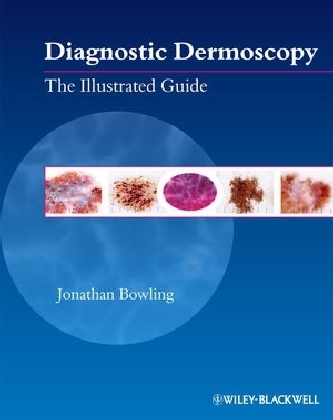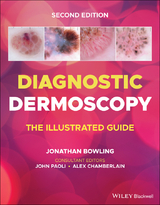
Diagnostic Dermoscopy
Wiley-Blackwell (an imprint of John Wiley & Sons Ltd) (Verlag)
978-1-4051-9855-4 (ISBN)
- Titel ist leider vergriffen;
keine Neuauflage - Artikel merken
Ideal for clinic use, both for diagnosis and for explaining to the patient, this guide provides: * A quick reference atlas guide to the diagnosis skin lesions, especially, but not limited to, those that are cancerous * Icons for each condition linked to high definition dermoscopy and clinical photographs * Real dermatoscopic images and the associated clinical photographs on the page opposite
Jonathan Bowling, MD, MRCP is consultant dermatologist and honorary senior clinical lecturer at the University of Oxford Department of Dermatology. He has been providing training in dermoscopy since 2002. To date over 500 UK doctors have attended his national one day courses in dermoscopy education. He is?a board member of the International Dermoscopy Society and lectures?internationally on dermoscopy.
Introduction to dermoscopy 1. Introduction 2. Instruments a. Introduction b. Non-polarised devices c. Polarised devices d. Hybrid devices e. Maintenance tips 3. Normal Skin a. Face, body and phototype b. Photodamage 4. Pigment depth and colour 5. Dermoscopic alphabet a. Global features b. Local features Melanocytic lesions 6. Melanocytic criteria a. Pigmented network b. Pigmented globules c. Homogeneous pigmentation d. Parallel pattern e. Cobblestone f. Starburst pattern 7. Pigmented network 8. Atypical pigmented network 9. Cobblestone 10. Globular 11. Dermal naevi 12. Blue naevi 13. Halo naevi 14. Recurrent naevi 15. combined naevi 16. Spitz naevi a. Pink b. Pigmented 17. Naevi and phototype a. Skin phototype I b. Skin phototype III 18. Naevi & age 19. Examples of predominant naevus morphology a. Globular homogeneous b. Patchy reticular c. Reticular d. Homogeneous 20. Multicomponent 21. Morphology 22. Pigment distribution Melanoma 23. 7 Features of melanoma a. Atypical pigmented network b. Blue white veil c. Atypical blood vessels d. Irregular dots & globules e. Irregular pigmentation f. Irregular streaks g. Regression structures 24. Melanoma features and thickness a. In-situ b. Thin invasive c. Intermediate thickness invasive d. Thick invasive 25. Melanoma colours a. Brown b. Black / hyperpigmented c. Pink / hypopigmented d. Multicoloured 26. Melanoma type a. Superficial spreading b. Nodular i. Pigmented ii. hypomelanotic c. Featureless d. Small e. Eccentric f. Cutaneous g. Negative h. regression 27. Algorithms a. 7-point checklist b. ABCD c. Menzies scoring method d. CASH e. 3-point checklist f. Limitations Non-Melanocytic lesions 28. Seborrhoeic keratosis a. Criteria b. Milia like cysts c. Comedo-like openings d. Cerebriform e. Fingerprint structures 29. Benign lichenoid keratosis 30. Ink spot lentigo 31. Solar lentigo 32. Clear cell acanthoma 33. Comedones 34. Porokeratosis 35. Haemangioma 36. Lymphangioma 37. Subcorneal haematoma 38. Sebaceous gland hyperplasia 39. Dermatofibroma a. DF vs Naevus b. Typical DF c. Non-typical DF 40. Actinic keratosis 41. Bowens disease 42. SCC & Keratoacanthomas 43. BCC a. Structures b. Superficial BCC c. Nodular BCC d. Morphoeic BCC e. Pigmented BCC f. Brown BCC 44. Blood vessels in skin lesions 45. External pigmentation 46. Radiotherapy scars Special sites 47. Acral lesions a. Acral anatomy b. Acral naevi c. Acral melanoma 48. Facial lesions a. Lentigo maligna b. Lentigo maligna melanoma 49. Nails a. Melanonychia b. Nail unit melanoma c. Nail unit SCC d. Erythronychia e. Subungual haematoma f. Nail unit Infections i. Bacterial ii. Fungal iii. Viral 50. Scalp tumours a. Melanoma b. BCC c. Naevus sebaceous d. Seborrhoeic keratosis 51. Hair a. Alopecia i. Non-scarring 1. Androgenetic alopecia 2. Alopecia areata 3. Trichotillomania ii. Scarring 1. Lymphocytic scarring alopecia 2. Neutrophlic scarring alopecia 3. End stage scarring - pseudopelade b. Miscellaneous hair conditions i. Trichostasis spinulosa ii. Ingrowing hairs iii. Pseudonits 52. Mucosal lesions a. Mucosal melanosis General dermatology 53. Skin infection a. Scabies b. Molluscum contagiosum c. Head lice d. Viral warts 54. Inflammatory skin disease a. Psoriasis / eczema b. Lichen planus c. Blood vessel inflammation /Capillaritis vs vasculitis d. Urticaria pigmentosa e. Granulomatous inflammation f. Dermatomyositis & scleroderma g. Xanthogranuloma Case scenarios 55. The nail lesion 56. The foot lesion 57. The hyperpigmented truncal lesion 58. The atypical mole 59. The purple ear lesion Reference points 60. 10 tips for better imaging 61. 10 tips not to miss melanoma 62. Key points for safe dermoscopy 63. Skin lesion management pathway Image gallery a. Naevi b. Seborrhoeic keratosis c. Hypopigmented seborrhoeic keratosis d. BCC nodular e. BCC superficial f. BCC - pigmented g. SCC h. Dermatofibroma i. Haemangioma j. Angiokeratoma k. Melanoma pink l. Melanoma - brown m. Melanoma black n. Melanoma arising in a naevus o. Melanoma atypical vessels p. Melanoma multicoloured q. Melanoma - globules r. Melanoma regression s. Melanoma - extensive regression t. Melanoma blue white veil and atypical network u. Melanoma SSMM v. Melanoma - blue white veil w. Melanoma streaks
| Verlagsort | Chicester |
|---|---|
| Sprache | englisch |
| Maße | 209 x 285 mm |
| Gewicht | 474 g |
| Themenwelt | Medizin / Pharmazie ► Medizinische Fachgebiete ► Dermatologie |
| Studium ► 2. Studienabschnitt (Klinik) ► Anamnese / Körperliche Untersuchung | |
| Studium ► 2. Studienabschnitt (Klinik) ► Pathologie | |
| ISBN-10 | 1-4051-9855-9 / 1405198559 |
| ISBN-13 | 978-1-4051-9855-4 / 9781405198554 |
| Zustand | Neuware |
| Informationen gemäß Produktsicherheitsverordnung (GPSR) | |
| Haben Sie eine Frage zum Produkt? |
aus dem Bereich



